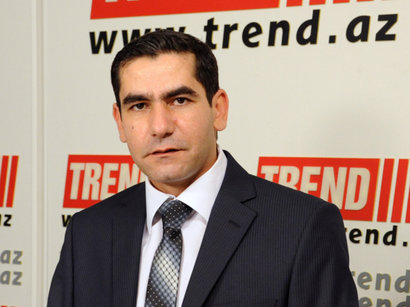Iran's clean energy basket and air pollution

By Dalga Khatinoglu
Head of Persian News Service of Trend Agency
While the global primary energy consumption increased by 27 percent during the last decade, Iran's energy usage rose by 80 percent.
Iran's energy consumption, which also experienced a significant increase since 2001, reached 1.6 billion crude oil equivalent (OE) in 2013, about 141 million more than the previous year.
Despite Iran's runaway energy consumption rate, the composition of the country's energy basket is satisfying.
The share of natural gas in the country's primary energy consumption is 70 percent, while this figure in 1980 was only 10.6 percent (20 million OE).
According to the National Iranian Oil Refining & Distribution Company's statistics, the gas consumption level has increased 50 fold since 1980.
The indicator in 2012 was 66.5 percent (1 billion oil equivalent), while Iranian officials put the country's total gas usage during last fiscal year (ended on March 20) at 180 billion cubic meters.
This amount of natural gas equals 1.32 billion barrels of crude oil and shares 70 percent of the country's 1.6 billion OE energy consumption.
The U.S. Energy Information Administration's statistics indicate that the global gas consumption had increased from 2.4 trillion cubic meters in 2000 to 3.4 tcm in 2012, indicating a 41 percent increase, while during this period Iran's gas consumption increased 248 percent, 6 times more than global growth level.
Besides the major share of natural gas in Iran's energy basket, the country's usage of coal is ignorable, about 900,000 OE in 2013, according to the BP's annual report, while the global coal consumption was above 27 billion OE during last year.
On the other hand, Iran ranks first in terms of the number of natural gas vehicles in the world, according to the Natural Gas Vehicle Knowledge Base.
The parliament Research Center's report, published in February indicates that there are 3.6 million bi-fuel vehicles in the country, alongside 8.57 million motorcycles.
There are about 15 million vehicles in Iran.
Iran has capacity to supply 20 mcm of liquid gas (CNG) to bi-fuel vehicles per day, the figure that give opportunity for Iranians to use about 20 million liters less gasoline. Iran's CNG consumption increased from 5 mcm in 1990 to 7 billion cmc in 2012.
Air pollution
In spite of a huge share of gas in Iran's energy basket, Iran is one of most air-polluted countries in the world.
The country ranked 12th (with 127 mg per cm in 2010) with four Iranian cities among the ten most polluted areas in the world, according to the World Health Organization, a United Nation's body. The conditions have worsened since 2010.
The first reason for the worsened situation is supplying the vehicles with non-standard gasoline and diesel during the last several years. Iran had also produced non-standard gasoline at petrochemical plants during 2009-2014 after a plunge in gasoline imports.
Before 2009, Iran was importing 40 percent of its gasoline demands. Because of the U.S. imposed sanctions on selling gasoline to Iran to persuade the Islamic Republic to curb its sensitive nuclear activities, Iran started producing non-standard gasoline in petrochemical plants.
Iran's new government headed by Hassan Rouhani cut the gasoline production in petrochemical units and boosted the fuel import again.
Air pollution costs $16 billion for Iranians annually, according to the World Health Organization. The previous administration put the cost value at $8 billion in 2011, however, resuming the risks and rewards of importing standard gasoline, the Rouhani's Administrasion seems to have made a positive decision.
Importing 5 to 8 million liters of gasoline per day, would cost even less than $2 billion, while Iran's petrochemical units now are able to engage in their own duty.
Another factor is that most of Iran's vehicles are not standard ones. For instance, the vice-president of Tehran Traffic & Transportation Organization Hojjatollah Behrouz said in January that there are one million autos (25 percent of total autos), and 1.5 million motorcycles in Tehran, manufactured with poor quality and low safety standards.
But, the major factor in Iran's air pollution is the fueling of power plants with fuel oil and diesel.
Iran's Oil Minister Bijan Namdar Zanganeh said earlier that that Iran was forced to consume 27 billion liters of fuel oil and diesel with high sulfur-content in power plants due to the gas shortage, last fiscal year.
Alireza Ahmadi Yazdi, an official at Iran Power Generation Transmission and Distribution Management Company (TAVANIR) had said on April 22 that some 222 million tons of the pollutants were produced as a result of using fossil fuel in power generation.
According to his statement, the fossil fuels totally produce 547 million tons of air pollutants in Iran. So, about 40 percent of the air pollution in the country is caused by power plants' activity.
The share of liquid fuels feeding Iran's power plants last year was 44 percent. National Iranian Oil Refining and Distribution Company's (NIORDC) annual reports from 2003 to 2012 indicate that the share of gas in fueling power plants decreased dramatically from 81 percent to about 61 percent based on heating value, while the gas-oil consumption share increased from 3 percent to 12 percent and the fuel oil share increased from 16 percent to 26 percent.
The flaring gas amount is also huge in Iran, reaching about 11 billion cubic meters annually.
There is a huge power loss during the transmission and distribution process, which reaches around 40 billion kwh, or more than 14 percent of total actual power generation capacity.
